The Welsh are descendants of the ancient inhabitants
of Britain, long before the arrival of the Angles in
the 5th century. The Welsh language also
has its roots in the language of the ancient British
and there is an actual unbroken tradition that
reaches as far back as the ancient time of existence of that language. To a large degree, the
language is deeply Christian, as proven by the
numerous medieval odes in honour of Orthodox Welsh
Saints, as well as by a rich hymnography.
Wales takes up an area of western Britain. Its
western coast is washed by the Atlantic Ocean and to
the east it borders with
England.
Its population is 2.5 million. In 1282 Wales lost
its independence and has since been governed by
England. In 1999 – and for the first time after 700
years, following a Referendum in all of Wales – the
country has once again acquired its own Senate and
can now take the initiative and responsibilities for
its own life.
At this very critical
moment
of Wales’ History, the Orthodox Church (which was
once the Church of the Welsh Nation) has an
opportunity to call the people of Wales to return to
their historical spiritual roots: to Orthodoxy.
THE HISTORY OF CHRISTIANITY IN WALES
Christianity came to Britain during the 1st
century A.D., upon which immediately began the
evangelization of the Celts (who were the first
inhabitants
of Britain).
Saint Aristobulus of the Seventy Apostles is
regarded as the Apostle to Britain.
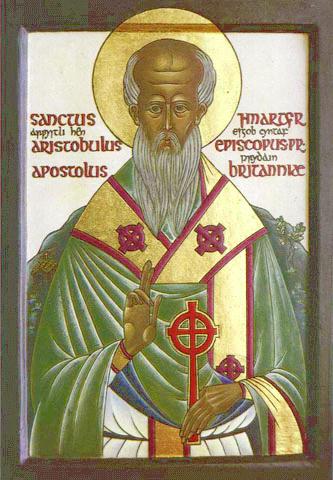
A flourishing Celtic Church - Orthodox in faith and
in practice - takes root in Britain and brings forth
a cloud of Saints, especially during the 6th and
7th centuries. Savage, idolatrous tribes
from the European mainland invade Britain, and the Christian Celts
move away towards the north and the east to safer
territories - to what is known today as Wales and
Scotland.
In 596 Saint Gregory the Pope of Rome sends
Saint Augustine (of Canterbury) to proselytize
the newcomers who had invaded Britain. The
roman mission came in contact with the local British
church and gradually "absorbed" it and placed it
under the jurisdiction of the English Archbishopric
of Canterbury and thereafter, under the authority of
Rome.
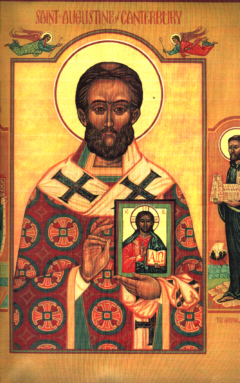
With the Great Schism of 1054 the Christian
world split in two: the original, Eastern Orthodox Church
and
the Roman-Catholic "church".
England's Christianity followed Rome.
In 1282
Llywelyn the last Prince of Wales is
assassinated and Wales loses its political
independence.
In 1536 Henry VIII - the 8th king of England
-
annexed Wales to England once and for all. He
proclaimed himself Head of the Church of England
(the Anglican Church) and broke away from Rome. His
chief administrator and legal advisor, Thomas Cromwell, destroyed
Monasteries, pilgrim sites and Temples with Holy
Relics throughout England (1536-1539). By degrees,
the Church of England became Protestant in faith and
in practice.

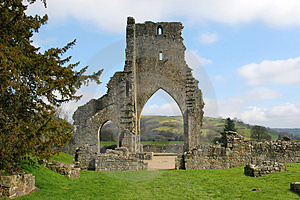
In the 18th century the Anglican Church was
spiritually very strong. It was for this reason that
the Methodists prevailed, especially in Wales:
because their theories, combined with Calvin's
theology, somehow suited the Welsh mentality.
During the second half of the 20th century, a
steep decline in Protestantism appeared in Wales.
Temples gradually emptied, however, Calvin's
theories had influenced the people's psychology and
had alienated them from the Church - and naturally
from God.
In 1973 Archimandrite Barnabas - the first
Welsh Orthodox priest after the Great Schism -
returns to his native land to live the monastic life
and embarks on his missionary labours, through to
his repose in 1996, at the age of 80.
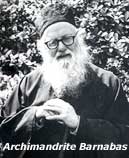
In 1979 the
Abbot Deiniol (Daniel) - another Welshman -
is ordained an Orthodox priest and takes on the
mission in Wales.
In 1998 fr. Luke, an Englishman, is ordained
and serves in southern Wales.
In 1999 Wales is officially recognized as a
nation; following a referendum, it acquires its own
Parliament. The Orthodox Church is officially
invited to participate in the parliamentary
commencement ceremony, with the request to offer up
a special prayer to the Lord through the
intercession of all the Welsh Saints - an act that
was prohibited by the Protestants - until now.
THE ORTHODOX MISSION IN MODERN WALES
In 1973 Archimandrite Barnabas returns to his
native land with the deep desire to found a monastic
brotherhood dedicated to the Prophet Elijah.
His desire was not fulfilled for various reasons. He
was always possessed by the zeal to preach the
Orthodox faith in his homeland, and laboured
tirelessly towards that goal, right up to the end of
his life. He daily performed all the services and
joyfully offered hospitality to the many visitors
in the monastery that he had built. He
published an informative periodical, he preached,
and he always responded to invitations from all over
Wales, and also outside it. He was well known
and respected by everyone in Wales. He frequently
spoke on radio programs and many Welsh heard about
Orthodoxy for the very first time - and in
fact in their native tongue - by a priest who was a
fellow-countryman. At last! An Orthodox priest
- the first after the Great Schism of 1054 - who
laboured in Wales as a missionary!
After the repose of fr.Barnabas, the
Monastery of the Prophet Elijah remained closed.
It is a fact that its location (near the English
borders) is not a suitable one. It is not located in
the heart of Welsh society with its linguistic
homogeny and its genuine tradition - an element that
the Orthodox Church needs to pay close attention to,
if it wishes to take root in Wales.
In the southern parts of Wales there have been
several Orthodox Christians, several years before
the Orthodox Church's revival. They were
mostly Greek women who had married Welsh soldiers
during the War and had come to live in their
husbands' homeland, where they eventually raised
their families. Their desire was to baptize their
children in the Orthodox Church. Little by little,
some of the locals began to discover the Orthodox
faith and to eventually join the Orthodox Church.
The town of Blaenau Flestiniog is situated
approximately in the centre of the nation, on a
central road that spans Wales from the south to the
north. In this town there used to be an Orthodox
temple of the Holy Protection, on a breathtaking slope
of Mount Manod (photo below).
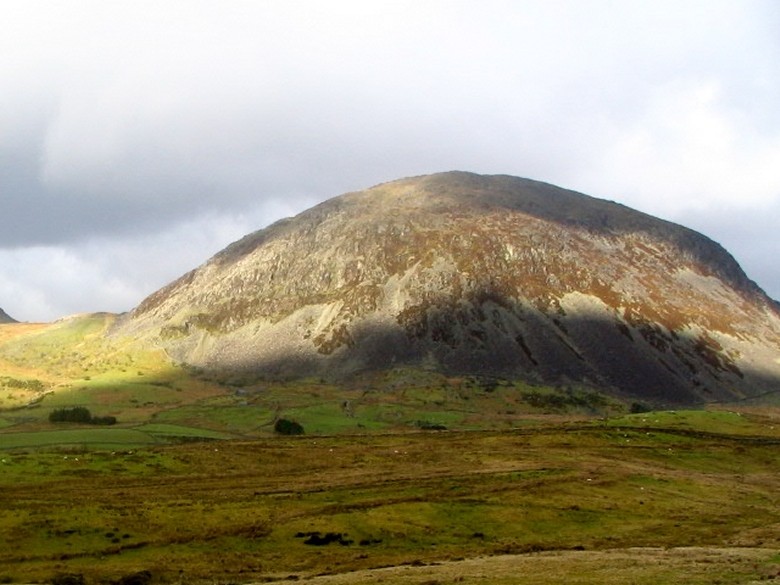
It was
in this church that fr. Deiniol (Daniel) was posted immediately
after his ordination in 1979 and where he attempted
to congregate the Welsh faithful. Basically,
the local language was used during Worship, but also
used were English, Greek and Slavonic. But it was
for the first time in modern-day history that an
Orthodox community began to grow, and with the use
of the Welsh language.
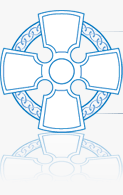


"Generally speaking, the town is poor and quite
depreciated. Its population of 12.000 citizens has
been reduced to 4.500, and with a high percentage of
unemployment. We shall also in the future continue
to be poor, unemployed, and with countless
difficulties. The young are deprived of prospects
and a purpose to their lives; but we do believe that
the Christian Church is the future of our society.
"In 1995 we began our intensified and
systematic missionary work.
"In 1996 and with the blessings of our
Bishop, the Orthodox Mission of Wales was officially
recognized; its main opus being to call upon all the
Welsh to return to the Orthodox faith.
"The people in Europe believe that they know
Christianity; but quite often they are misguided,
because theirs is not a knowledge of Christianity;
rather, it is a caricature of Christianity. Fr.
Barnabas used to say that the people in the West had
so much Christianity, that they.... were
impervious to it!
"However, we believe that it is now time for the
Europeans to acquaint themselves with the Gospel of
Christ, not their own religions, and with the
sacramental life of the Church. That is the scope of
our missionary endeavour also.
"In Wales, apart from the difficulties that the
entire population of Europe has - i.e. materialism
and overspending - there are also certain other
problems:
- Centuries of
Calvinism in Wales have made the people believe
that God is NOT a loving Father but a tyrant Whom
they must fear.
- The
Protestant dogmas also played a role in
splitting society into "the just" and "the sinners",
and caused many people to be regarded as outcasts.
"In the
face of
this mentality, it is imperative for the Church to
preach the love, the joy, the acceptance and the
forgiveness that God offers. This is the
direction in which the Orthodox of Wales have turned
their endeavours. The ecclesiastic hymns that were
recorded on tapes in our language had a hugely
positive response. It was also very important for us
to have hagiographic icons of the Saints of our
land. All the Christians want to have them in
their homes. Most of them were produced by the
hagiographer Gregory Papageorgiou from Cyprus. (St.Dewi
icon below)
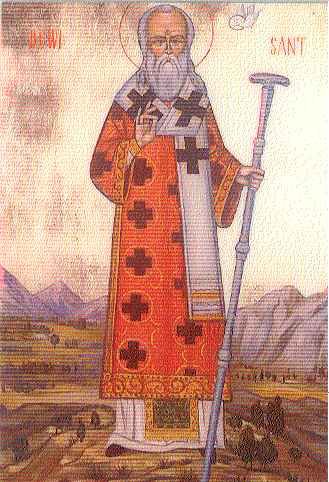
DEWI SANT,
Patron Saint of Wales.
Icon by
G. Papageorgiou
at the Orthodox Church of the Holy Protection,
Blaenau Ffestiniog
"The first icon to be fashioned was that of Saint
Cadwaladr, followed by Saint Lestyn the Monk, Saint
Melangell the Abbess (now known in Greece also),
Saint Pabo the King, Saint Åilian the Pilgrim, and
Saints Cybi and Seiriol who founded monastic
brotherhoods on the islands of northern Wales.
Christmas cards with Welsh saints, as well as
several pamphlets with the lives of saints -
including Saint Nectarios - were printed, in the
Welsh language.
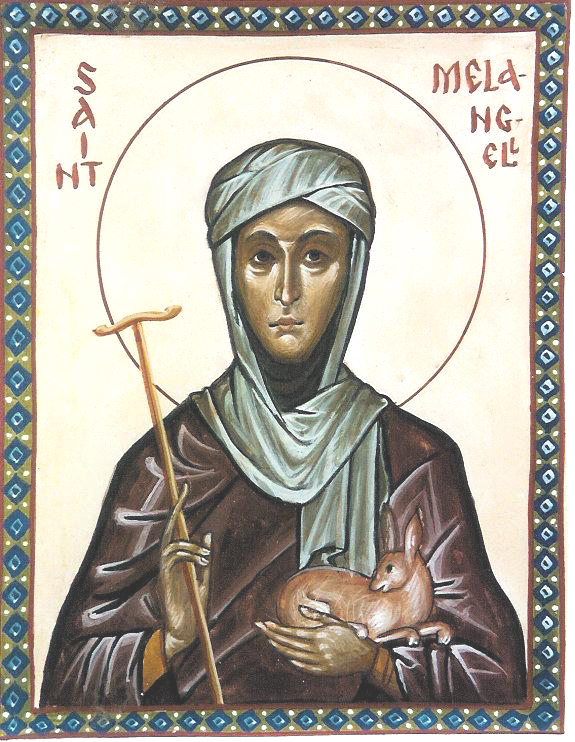
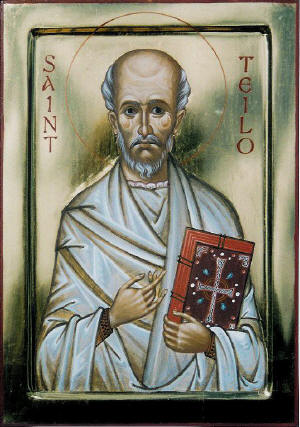
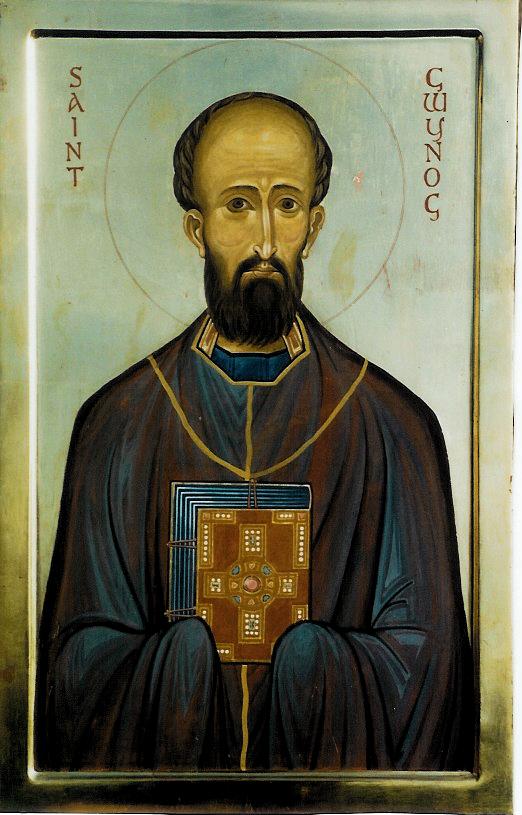

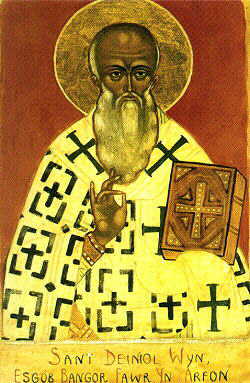
St. Melangell
St. Teilo
St. Gwynog
St. Twrog
St. Deiniol
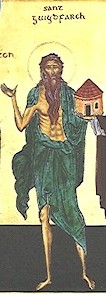

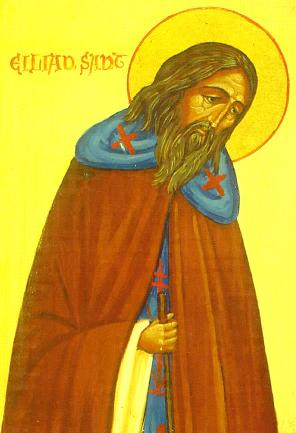
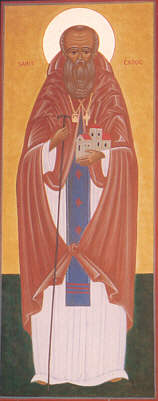
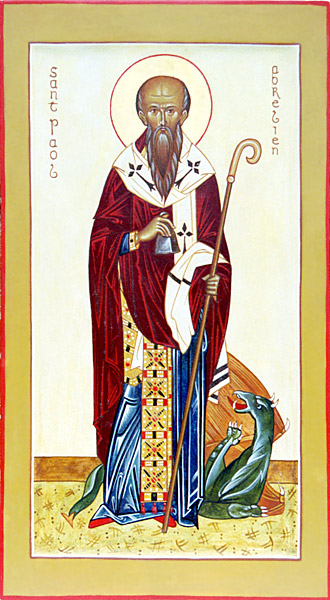
St. Cadfarch
St. Tyssilio
St. Eilian St. Cadoc
St. Paul Aurelian
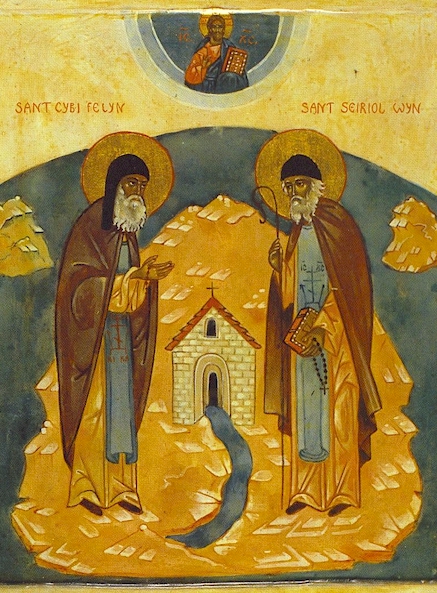
Saints
Cybi and Seiriol

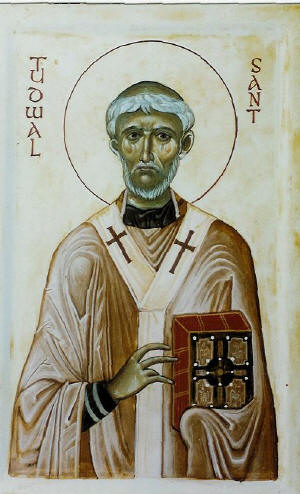
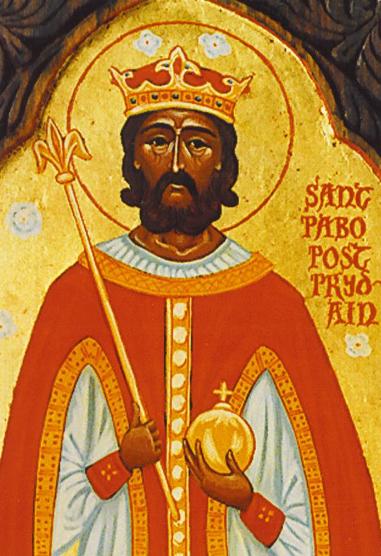
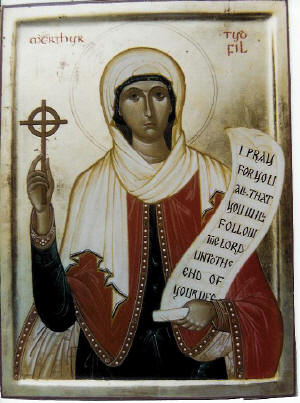
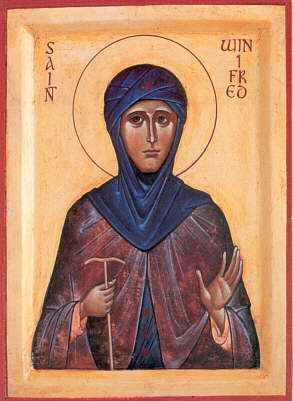
Holy
Hierarch St. Owen St. Tudwal
St. Pabo Post Prydain
St. Tydfil
St. Winifred
"In our missionary work, we made use of the mass
media, with homilies, discussions on matters of the
faith and the life of the Church. Many people
nowadays watch televised programs that concern the
Orthodox Church; they read related articles in local
newspapers and they attend lectures and public
discussions on the Orthodox Church and Faith.
School children, college students, various groups of
young or old visit the Orthodox temple where the
rector, fr. Daniel answers their innumerable
questions. Those visits always end with the
Minor Paraclesis (prayer of supplication) addressed
to the Holy Mother Theotokos.
"Many are the daily opportunities that we are given
to minister to the people of God, from within that
temple in the town of
Blaenau. In accordance with the tradition of
our Church, we strive to serve the people of our
local community and especially those who live
isolated, disillusioned, marginalized - in their
very homeland, and even in their own families.
This ministry brings us in touch with people who are
suffering, unemployed, abandoned, homeless, with
broken families... basically, with a host of social
problems. To all of them, we desire to bring the
message of the Orthodox Christian Faith and the
fulfilment of the Eucharistic life, which is none
other than the Kingdom of God.
"In July of 1999 our Bishop informed us that
a new church will be built in Âlaenau, which will be
dedicated to "All Saints of Wales". This
message was to us a source of great joy.
Archimandrite fr. Zenon - a major Russian
hagiographer - promised to fashion the Icon of All
Saints of Wales. With a missionary spirit
strengthened by the intercessions of all our Saints
- who were themselves missionaries - we believe that
this is how we too shall continue. And in the words
of our Bishop: "The parish must become a beacon of
Orthodoxy, which will shine upon all the people in
Wales."
"After one thousand years, Orthodoxy has finally
returned to Wales and our Church commenced Her
missionary work in a land that has been Orthodox
from the first centuries A.D.. The Welsh
people are invited to return to their roots, to the
Faith of their Saints, to their sources, to the
upright faith and practice.
Translation: K.N.
=======================
Welsh saints to adorn Orthodox church
(A
news item from the Orthodox website:
http://southern-orthodoxy.blogspot.com/)
Jan 24 2005, Rhodri Clark, Western Mail
A CHURCH in North Wales could be decorated with
frescoes of hundreds of Welsh saints to cement its
links with ancient Celtic Christianity.
The long list of Welsh saints includes each one
commemorated in a place name starting with "Llan",
as well as St Patrick and others remembered mainly
for their work outside Wales.
Father Deiniol, who founded the Wales Orthodox
Mission more than 20 years ago, said there were so
many saints that there would not be enough room in
his Blaenau Ffestiniog church for each one.
"We could include one from every part of Wales,"
said Fr Deiniol, known locally as Y Tad Deiniol.
A religious artist in Colwyn Bay has expressed
interest in the job, but would first have to learn
how to paint icons in the traditional Orthodox
style.
Fr Deiniol has decided against building an onion
tower - a powerful symbol of Orthodox churches in
Russia and elsewhere - on his former Anglican church
in Blaenau Ffestiniog.
"We thought about that once
but we asked, 'What would that be saying?' It's very
foreign. We're not Russians or Greeks, we're Welsh.
The onion tower is not part of our tradition."
He is chaplain in Bangor and Aberystwyth, where some
of the university students are from Greece, Russia
and other countries with a predominantly orthodox
faith. Services at his church in Blaenau Ffestiniog
can attract up to 300 people at key festivals in the
calendar such as Easter.
The history of Fr Deiniol's mission will be retold
in an hour-long documentary on S4C on Tuesday,
February 1, 2006.